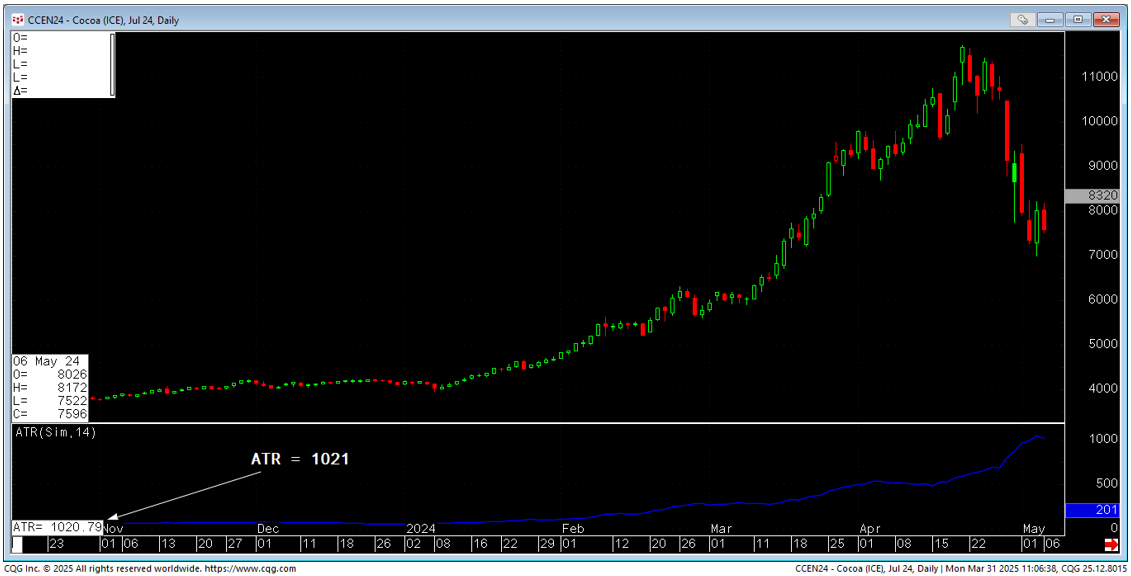In Schwager's "Market Wizards" he interviewed Larry Hite who came up with the gold standard for position sizing, which is to limit risk to 1% of total assets under management per position. In previous articles I've discussed augmenting this 1% rule with correlation analysis (see "Three-Tiered Approach to Managing Risk" ). In this article I'd like to explore the nuances of applying the 1% rule vis-à-vis account size (aka "assets under management").
Lots of emerging CTAs set their account size minimum for investors at $100,000.00 USD in order to quickly grow their fund, while others set their minimum at $1 million or even $5 million. Why is there such a large discrepancy? Let's look at what happens when we apply the 1% rule to a $100,000.00 account that uses a historical volatility indicator like Average True Range as a stop loss. For those unfamiliar with Wilder's Average True Range, it is a historical measure of volatility of the asset over a given lookback period. The true range indicator is taken as the greatest of the following: current high less the current low; the absolute value of the current high less the previous close; and the absolute value of the current low less the previous close. The ATR is then a moving average, generally using 14 days, of the true ranges.
What happens when we apply a stop loss of 1*ATR to our $100,000.00 trading account? For a manager trading May, 2022 ICE Cocoa on 3/17/22 their stop would be 69.29 or 69 points or $690 risk or 1 contract since two contracts would be $1,390.00 risk which is more than 1% of a $100K account (see Figure 1 below).
Figure 1: May, 2022 ICE Cocoa
The problem for our $100K account occurs around two years later when the 14-day ATR in July, 2024 Cocoa is 1021 or $10,210.00 per contract, which translates to our $100K account risking over $10K to trade one contract of Cocoa (see Figure 2 below). Given this new level of historical volatility, our CTA has three choices:
- Increase the minimum account size for its investors from $100,000.00 to $1.1MM, thus enabling their participation in July '24 Cocoa without breaking the 1% risk threshold
- Increase the maximum per position risk threshold from 1% to 11% of Assets Under Management (AUM)
- Temporarily omit Cocoa from the universe of potential trading instruments until its 14-day ATR again falls below 100 points.
Given these three alternatives, virtually every CTA out there chooses to simply omit Cocoa from its potential portfolio.
Figure 2: July 2024 ICE Cocoa
This is the big negative to offering a low minimum account size (e.g. $100K) to potential investors. Even if you increase the minimum account size from $100K to $500K you'd still have to omit Cocoa from the portfolio (at least temporarily).
Although it could be argued that July, 2024 Cocoa is an outlier and at $500K you'd be able to trade at least one contract of virtually every asset offered, there are still less severe, yet serious problems with a $500K account size minimum. For example, let's say that you are trading the entire complex of petroleum futures (including crude oil, unleaded gasoline and middle distillates). Even in a relatively low volatility environment such as Fall, 2024 you'd have to make difficult decisions regarding exposures in the complex including omission of at least one of the three aforementioned subcategories (see Table 1 Below).
Table 1: Percentage of Assets Under Management Exposures in Petroleum Complex (assuming $500K Account size)
A final consideration for managers in setting their minimum account size is, "rounding errors". When we set the account minimum to a low level such as $100K, not only do we lose exposure in some of the potential assets within the diversified portfolio, we also risk overweighting of some assets and underweighting of others. Here's an illustration, on 3/31/25 the June '25 CME Group Mexican Peso futures contracts had an ATR of 44 points, $5.00*44 = $220.00. One percent risk on $100K is $1,000.00, 1,000/220 = 4.54, so we'd round down to 4 contracts. Now let's compare this to the May '25 CME Group Soybean Futures contracts which had an ATR of $0.1275 or $637.50 per contract on 3/31/25. Since we can't violate our 1% risk threshold, we can only trade one contract of soybeans even though the ATR is pretty close to being able to trade 2 contracts (this is commonly known as a "rounding error"). Notice that the rounding error diminishes as assets under management increases.
In conclusion, although emerging CTAs are often loath to turn away investors, be aware that there's still no free lunch in financial mathematics and by offering a lower threshold to entry for potential investors they often sacrifice asset diversification as well as subjecting themselves to a greater potential impact on the portfolio to rounding errors.


